From above, sailing regattas transform into a mesmerizing spectacle. You'll witness geometric patterns formed by sails, creating striking contrasts against the water. The scale becomes apparent as boats appear tiny in the vast expanse. Dynamic movements unfold as vessels tack and jibe, leaving intricate wake trails. Color bursts from spinnakers add vibrancy to the scene. You'll observe tactical maneuvers and race strategies that are invisible from the shore. The regatta's infrastructure, including support boats and viewing areas, becomes clear. Unique vantage points, like tall buildings or helicopters, offer unparalleled perspectives. There's so much more to discover about this aerial ballet on the water.
Geometric Patterns of Sails
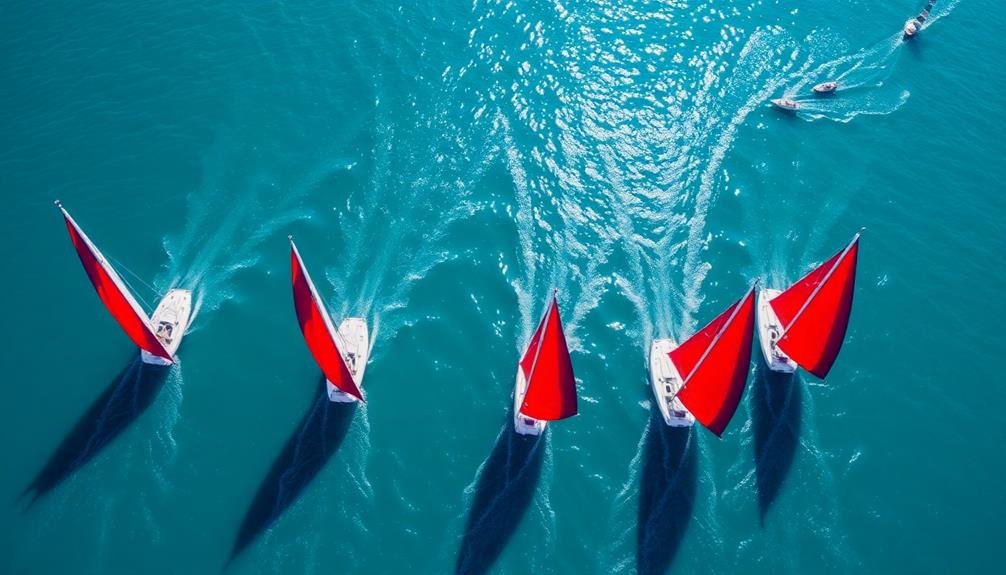
Sailing regattas' most striking visual feature is often the geometric patterns formed by the boats' sails. From above, you'll see a mesmerizing array of triangular shapes cutting through the water. These sails, typically white against the blue sea, create a stark contrast that's visually arresting.
As the boats tack and jibe, the patterns shift and evolve. You'll notice how the sails change orientation, sometimes appearing as perfect isosceles triangles, other times as scalene shapes depending on the wind direction. The symmetry of spinnakers, the large, balloon-like sails used for downwind sailing, adds another layer of geometric interest.
In fleet races, you'll observe how the boats cluster together, their sails forming a patchwork of triangles that move as one entity. During starts, the boats line up, creating a near-perfect row of identical shapes.
As the race progresses, this uniformity breaks apart into more organic arrangements, but the geometric essence remains. The interplay of light and shadow on the sail surfaces further enhances these patterns, creating a dynamic, ever-changing visual spectacle.
Color Contrasts on Water
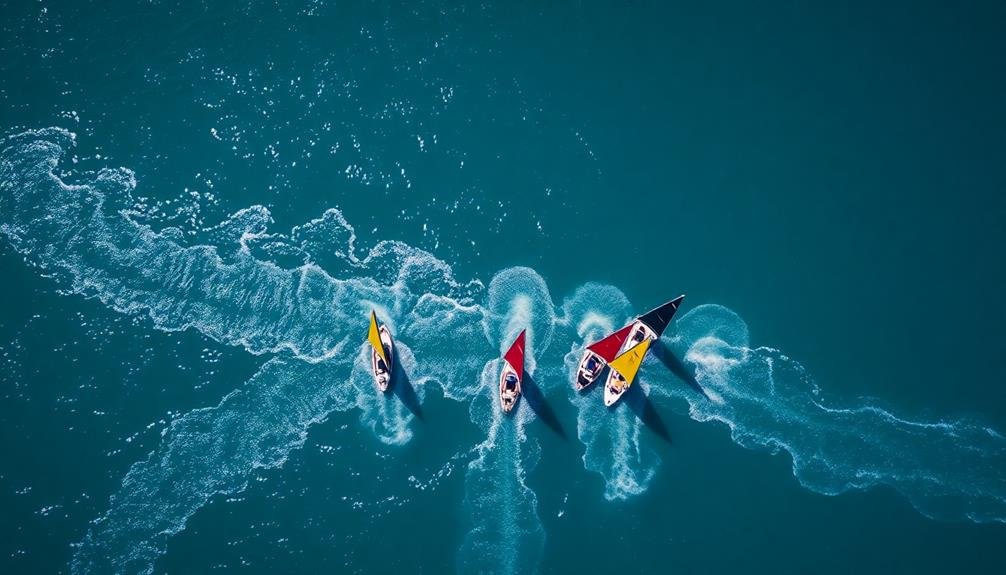
In addition to the geometric patterns, you'll be struck by the vivid color contrasts during sailing regattas. The stark white sails stand out brilliantly against the deep blue or green waters, creating a mesmerizing visual spectacle.
You'll notice how the sunlight reflects off the water's surface, adding a shimmering quality to the scene and enhancing the contrast between the boats and their surroundings.
As you observe from above, you'll see how different sail colors pop against the water. Spinnakers, the large, balloon-like sails used for downwind sailing, often feature bold hues like red, yellow, or blue.
These vibrant colors create stunning focal points amidst the sea of white sails. The contrasts are particularly striking when boats are grouped closely together, forming a patchwork of colors against the uniform water backdrop.
You'll also spot how the water's color changes with depth and lighting conditions. Shallow areas may appear turquoise or emerald, while deeper waters take on a darker, more intense hue.
This natural gradient serves as a dynamic canvas for the sailing vessels, further accentuating their presence and movement across the regatta course.
Scale and Perspective

From a distance, you'll gain a new appreciation for the scale and perspective of sailing regattas. Aerial views reveal the true magnitude of these events, showcasing dozens or even hundreds of boats spread across vast expanses of water.
You'll notice how tiny individual vessels appear in relation to the surrounding landscape, emphasizing the sheer size of the bodies of water they navigate.
The bird's-eye view allows you to observe intricate patterns formed by the boats as they maneuver through the course. You'll see how they cluster at starting lines, fan out during races, and converge at turning marks.
This perspective highlights the strategic positioning of each vessel and the skill required to navigate through the fleet.
From above, you can also appreciate the regatta's context within its environment. You'll observe how the sailing area relates to nearby landmasses, harbors, and other geographic features.
This vantage point reveals the challenges posed by currents, wind patterns, and natural obstacles that mightn't be apparent from sea level, giving you a deeper understanding of the tactical decisions sailors must make throughout the race.
Dynamic Movement Captured

You'll be mesmerized by the visual symphony of a sailing regatta in full swing.
Patterns of sail formations create a ever-changing tapestry on the water, while wake trails and ripples mark the paths of boats slicing through the waves.
Your eyes can't help but be drawn to the vibrant bursts of color as spinnakers unfurl, adding a dynamic flair to the already enchanting scene.
Patterns of Sail Formations
Against the backdrop of a shimmering sea, sailing regattas come alive with mesmerizing patterns of sail formations. As you gaze down from above, you'll notice how the boats organize themselves into distinct shapes and configurations. These formations aren't just random; they're strategic maneuvers that sailors use to gain an advantage in the race.
You'll spot triangular formations as boats jockey for position at the starting line, creating a striking visual effect. As the race progresses, you'll see boats spreading out into long, undulating lines as they tack upwind.
When rounding marks, the fleet often bunches together, forming tight clusters that resemble schools of fish.
Downwind legs create some of the most spectacular sights. Spinnakers unfurl, and boats fan out across the course in a colorful array. You might even catch glimpses of symmetrical formations as teams employ tactical positioning to block their competitors' wind.
These ever-changing patterns showcase the sailors' skills and strategy, transforming the regatta into a dynamic, living artwork on the water's canvas. The formations evolve constantly, offering a fascinating aerial spectacle throughout the entire event.
Wake Trails and Ripples
Trails of frothy white wake stretch behind each sailboat, etching their paths across the water's surface. You'll notice how these wake patterns vary depending on the boat's speed and direction. Fast-moving vessels create longer, more pronounced trails, while slower ones leave subtler traces.
As you observe from above, you'll see an intricate network of ripples emanating from each boat. These concentric circles interact with one another, creating a mesmerizing display of water dynamics. The wind's influence on the water's surface adds another layer of complexity, with small wavelets crisscrossing the larger patterns.
Here's a breakdown of wake and ripple characteristics:
| Wake Type | Speed | Wind Influence | Visual Impact |
|---|---|---|---|
| V-shaped | High | Minimal | Dramatic |
| Straight | Medium | Moderate | Clear |
| Dispersed | Low | Significant | Subtle |
| Curved | Varied | High | Dynamic |
You'll find that these wake trails and ripples aren't just visually appealing; they're also indicators of sailing tactics and conditions. By studying these patterns, you can gain insights into wind directions, current flows, and the strategies employed by different crews during the regatta.
Colorful Spinnakers Unfurled
Moving from the water's surface to the air above, the most eye-catching feature of any sailing regatta is certainly the colorful spinnakers. These large, billowing sails are designed to catch the wind and propel boats downwind at high speeds. From an aerial perspective, you'll see a vibrant display of colors and shapes as crews hoist and trim their spinnakers.
The dynamic movement of these sails creates a mesmerizing spectacle:
- Unfurling: Watch as spinnakers burst open like blooming flowers, instantly transforming the boat's silhouette.
- Pulsing: Observe the constant adjustments made by crews, causing the sails to pulse and shift with the wind.
- Collapsing: Witness the controlled chaos as spinnakers are doused and stowed during maneuvers.
- Changing: See the rapid sail changes as boats round marks, swapping spinnakers for different wind angles.
You'll be captivated by the interplay of colors against the blue water and sky. The spinnakers' shapes and sizes vary, from asymmetrical kites to traditional symmetrical designs.
This aerial view showcases the sailors' skill in handling these powerful sails, adding an element of artistry to the competitive sport.
Aerial Choreography of Vessels
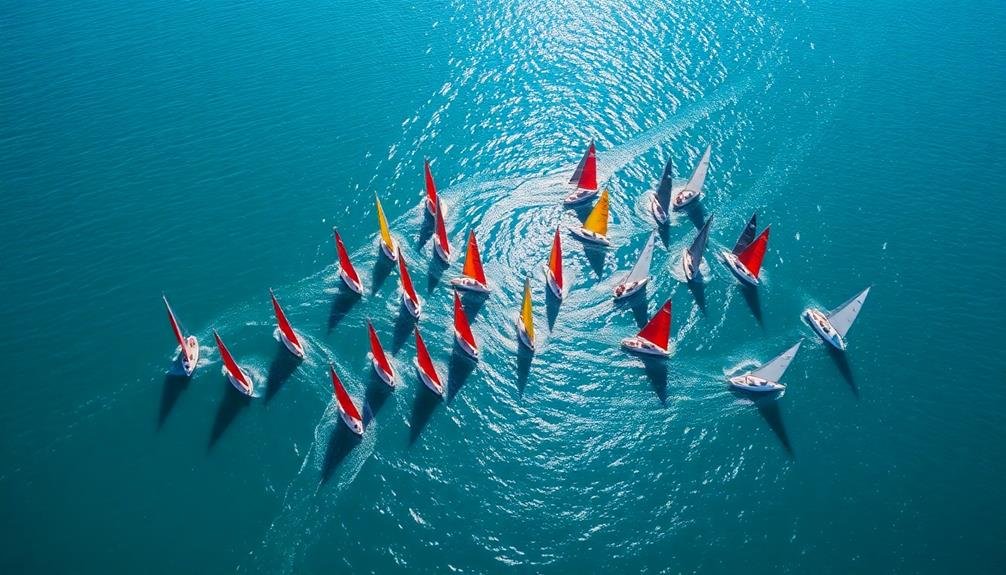
As you gaze down from above, the spectacle of sailing vessels in a regatta unfolds like a meticulously planned dance. You'll notice how boats cluster together at the starting line, jostling for position before the race begins. Once they're off, you'll see them fan out across the water, each seeking the best wind and current conditions.
The aerial view reveals patterns you can't appreciate from sea level. You'll observe how boats tack and jibe in unison, responding to shifts in wind direction. The fleet's movement creates mesmerizing geometric shapes that constantly evolve:
| Formation | Description | Visual Impact |
|---|---|---|
| V-shape | Lead boats pull ahead | Arrow-like precision |
| Diamond | Mid-pack positioning | Symmetrical beauty |
| Scattered | Individual strategies | Chaotic energy |
| Line abreast | Approaching a mark | Coordinated power |
| Funnel | Converging on finish | Dramatic conclusion |
From above, you'll appreciate the skipper's skill in maneuvering through the pack, making split-second decisions to gain an advantage. The regatta becomes a living, breathing entity, with each boat playing its part in an intricate maritime ballet that's as thrilling as it is beautiful.
Light and Shadow Interplay
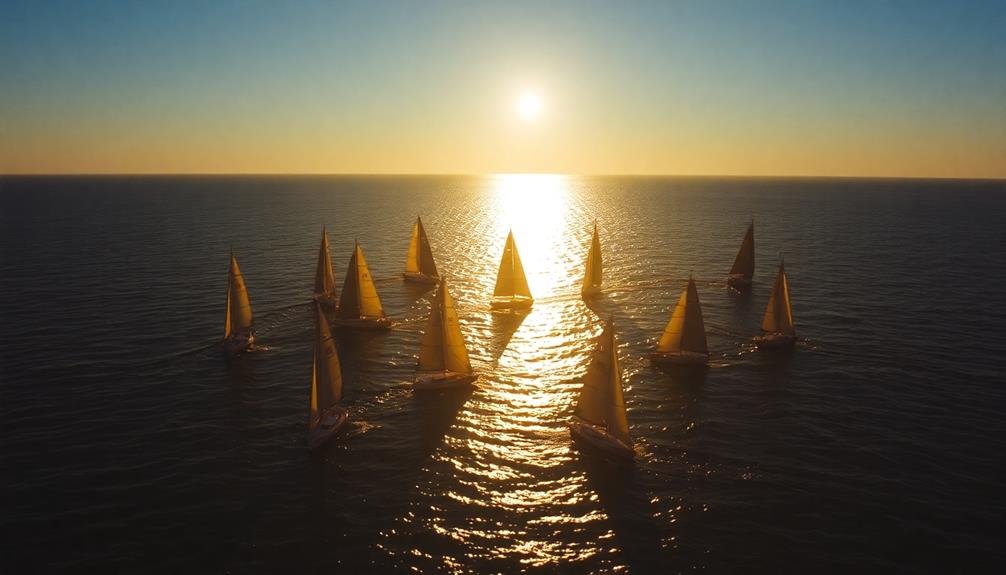
Have you ever noticed how light dances across the water during a sailing regatta? From above, you'll witness a mesmerizing interplay of light and shadow that transforms the seascape into a living canvas. As the sun's rays strike the water's surface, they create a shimmering tapestry that constantly shifts with the movement of the boats and waves.
You'll be captivated by the following visual elements:
- Reflections of sails on the water, creating elongated mirror images
- Shadows cast by the boats, stretching and contracting with the sun's position
- Sunlight glinting off the polished hulls and rigging
- The contrast between sunlit areas and shaded patches on the water's surface
The angle of the sun plays an essential role in this spectacle. During golden hour, just after sunrise or before sunset, the low-angled light bathes the scene in warm hues, intensifying the contrast between light and shadow.
Midday sun creates shorter, more defined shadows, while overcast conditions diffuse the light, softening the overall appearance.
This ever-changing interplay of light and shadow adds depth, drama, and visual interest to the regatta, making it a truly spectacular sight from above.
Wake Patterns and Textures

As you observe the sailing regatta, you'll notice intricate wake patterns trailing behind each vessel.
You'll see foam and ripple formations created by the boats' hulls cutting through the water, forming distinctive V-shaped patterns.
The wind's influence on the water's surface adds another layer of texture, creating wind-driven patterns that interact with the boats' wakes to produce a dynamic seascape.
Foam and Ripple Formations
Gliding across the water's surface, sailboats leave a mesmerizing trail of foam and ripples in their wake. These formations create a stunning visual spectacle that's best appreciated from an aerial perspective. As you observe the regatta from above, you'll notice the intricate patterns of foam and ripples that each boat generates.
The foam formations are a result of air bubbles trapped in the water, creating a white, frothy trail behind the sailboats. This foam can persist for several minutes, leaving a temporary record of the boat's path. Ripples, on the other hand, are the subtle waves that radiate outward from the boat's hull as it cuts through the water.
From your vantage point, you'll see four distinct types of foam and ripple formations:
- V-shaped wakes trailing behind each boat
- Circular ripples emanating from the hull's impact points
- Feathery foam patterns along the edges of the wake
- Intersecting ripple patterns where multiple boats' wakes collide
These foam and ripple formations not only add visual interest to the regatta but also provide insight into the boats' speed, direction, and maneuvering strategies.
As you watch the race unfold, you'll gain a deeper appreciation for the artistry and science behind sailing.
Wind-Driven Surface Patterns
Wind plays a starring role in creating mesmerizing surface patterns during sailing regattas. As you observe from above, you'll notice intricate textures and wake patterns that tell the story of wind-water interaction.
You'll see long, parallel streaks called wind rows stretching across the water's surface. These form when consistent winds organize surface currents into alternating bands.
Cat's paws, small dark patches on the water, indicate gusts of wind hitting the surface. They're often the first sign of an approaching breeze.
Look for chevron patterns trailing behind sailboats, revealing their recent path and speed. Faster boats leave wider, more pronounced wakes.
In areas of stronger wind, you might spot whitecaps—small, white-crested waves that pepper the surface.
During race starts, you'll observe a flurry of activity as boats jockey for position, creating a complex network of intersecting wakes.
As the race progresses, these patterns spread out, leaving a visible trail of each boat's tactical decisions.
These wind-driven surface patterns not only enhance the visual spectacle but also provide valuable information to sailors and spectators alike.
Crowd Formations on Shore

Along the shoreline, spectators gather in distinct formations to watch the sailing regattas unfold. You'll notice these crowd patterns forming unique shapes that complement the spectacle on the water. From above, you can see how the shoreline becomes a living, breathing entity as people move and cluster.
The most common crowd formations you'll observe include:
- Linear stretches along piers and boardwalks
- Dense semicircles around prime viewing spots
- Scattered groups on beaches and grassy areas
- Organized blocks in designated viewing stands
As you scan the shore, you'll spot pockets of color where spectators have set up umbrellas, tents, and picnic blankets. These temporary installations create a patchwork effect, adding visual interest to the landscape.
You'll also notice movement patterns as people shift positions to follow the action on the water. The ebb and flow of the crowd mirrors the rhythms of the race, with surges of excitement rippling through the formations as boats round markers or cross the finish line.
From your aerial vantage point, you'll witness how these human elements become an integral part of the regatta's visual appeal.
Weather Effects From Above

As you gaze down from above, you'll notice the intricate dance of cloud patterns and formations that frame the regatta scene.
You can't miss the wind-driven wave patterns, creating a dynamic canvas on which the sailboats navigate.
The interplay of light and shadow adds depth to the spectacle, highlighting the boats' movements and enhancing the overall visual drama of the event.
Cloud Patterns and Formations
Countless cloud formations paint a mesmerizing backdrop for sailing regattas, offering both visual splendor and vital weather information.
As you gaze down from above, you'll notice how these aerial patterns play a significant role in the spectacle and strategy of the race.
You'll encounter various cloud types, each with its own significance:
- Cumulus clouds: These puffy, cotton-like formations often indicate fair weather and thermal activity, potentially creating localized wind patterns.
- Stratus clouds: Low-lying and uniform, they might signal stable conditions but can also hint at approaching frontal systems.
- Cirrus clouds: High, wispy clouds that could forecast changing weather patterns in the coming days.
- Cumulonimbus clouds: Towering thunderheads that demand caution, as they're associated with strong winds and potential storms.
Wind-Driven Wave Patterns
Aerial observers of sailing regattas can't miss the intricate patterns etched across the water's surface by wind-driven waves. These patterns offer valuable insights into wind conditions and can influence race strategies.
You'll notice different wave types depending on wind speed and duration:
| Wave Type | Wind Speed | Appearance |
|---|---|---|
| Ripples | 0-3 knots | Small, circular |
| Chop | 4-10 knots | Short, irregular |
| Swells | 11-21 knots | Long, rolling |
| Whitecaps | 22+ knots | Breaking, foamy |
| Breakers | 30+ knots | Large, crashing |
From above, you can spot wind shadows created by landmasses or larger vessels, where the water appears calmer. You'll also see wind lanes, strips of water with stronger winds, marked by darker colors and more pronounced wave patterns.
Pay attention to wave direction changes, which indicate shifting winds. These shifts can create opportunities or challenges for sailors, influencing their tactical decisions during the race.
Light and Shadow Interplay
The interplay of light and shadow creates a mesmerizing spectacle for aerial observers of sailing regattas. As you gaze down from above, you'll witness a dynamic canvas of contrasting hues and patterns. The sun's angle plays a vital role, casting long shadows from sails and masts across the water's surface. These shadows dance and shift with the wind and waves, creating an ever-changing tableau.
You'll notice how different weather conditions dramatically affect the visual impact:
- Clear skies allow for crisp, defined shadows and vibrant reflections on the water.
- Partly cloudy days create a patchwork of light and dark areas, adding depth to the scene.
- Overcast conditions soften the contrast, emphasizing the subtle variations in water color.
- Low-angle sunlight, especially during sunrise or sunset, bathes the regatta in warm, golden hues.
The interplay of light and shadow isn't limited to the water's surface. You'll observe how sunlight glints off the sails, creating flashes of brilliance as boats tack and jibe.
This dazzling display, combined with the intricate patterns of shadows on the water, transforms the regatta into a breathtaking aerial spectacle that's constantly evolving throughout the day.
Coastal Landscapes as Backdrops
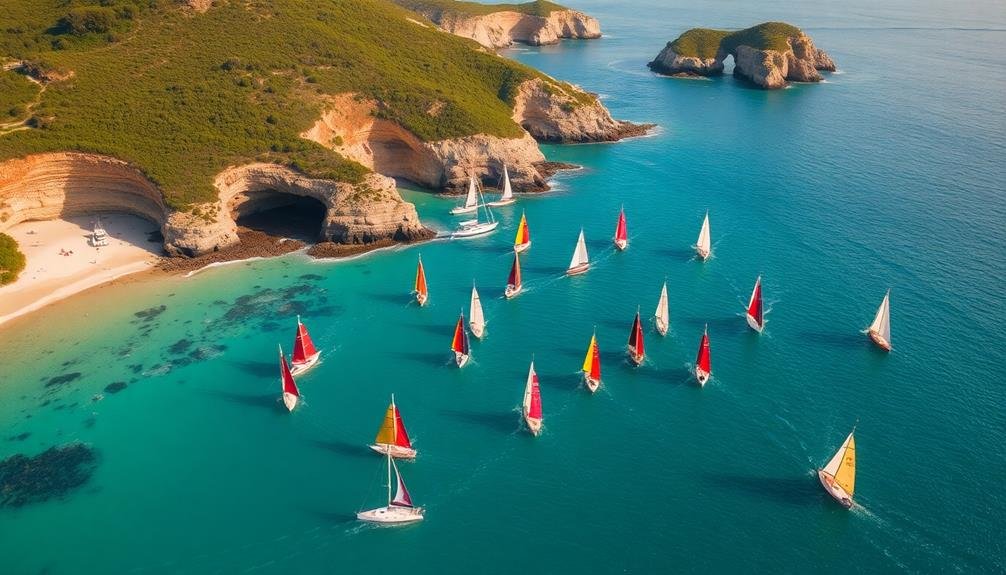
Framing the sailing action, coastal landscapes provide stunning backdrops for regattas worldwide. You'll find that these natural settings enhance the visual appeal of sailing events, offering a diverse range of scenery that captivates spectators and photographers alike.
As you observe regattas from above, you'll notice how different coastal features create unique visual compositions:
| Coastal Feature | Visual Impact |
|---|---|
| Rugged cliffs | Dramatic, towering backgrounds |
| Sandy beaches | Soft, golden contrast to the sea |
| Rocky outcrops | Textured, irregular shorelines |
| Lush vegetation | Vibrant green accents |
| Harbor towns | Colorful, human-scale elements |
These landscapes don't just serve as pretty pictures; they often play a significant role in the race itself. You'll see how sailors navigate around headlands, use land features for wind protection, or battle coastal currents. The interplay between boats and backdrop creates a dynamic visual narrative that tells the story of each race.
When you're capturing regatta images from above, you'll want to reflect on how the coastal landscape frames the action. Look for opportunities to showcase the contrast between nature's grandeur and the human-scale drama of competitive sailing.
Start Line Excitement
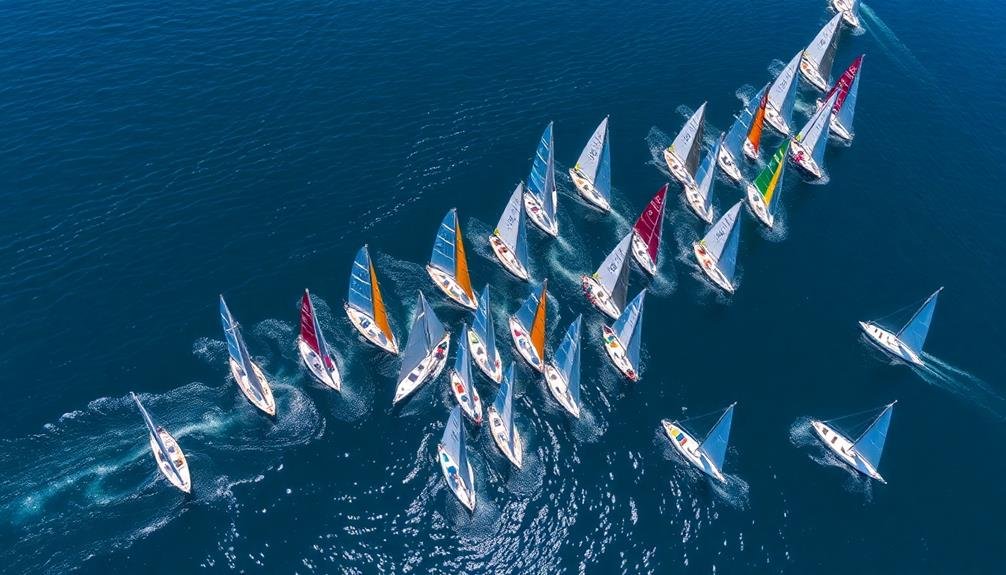
Anticipation builds as sailboats jockey for position at the start line.
You'll witness a flurry of activity as crews make last-minute adjustments and skippers strategize their approach. From above, you'll see the regatta's start unfold like a choreographed dance, with boats weaving in and out, vying for the best position.
As the countdown begins, you'll notice:
- Sails filling with wind, creating a vibrant patchwork of colors against the water
- Crews working in perfect sync, trimming sails and adjusting rigging
- Skippers maneuvering their vessels with precision, aiming for ideal starting positions
- Support boats patrolling the perimeter, ensuring fair play and safety
The tension reaches its peak as the start gun fires.
In an instant, dozens of boats surge forward, their bows cutting through the water. You'll marvel at the sudden burst of speed and the skill required to navigate through the pack without collision.
From your aerial vantage point, you'll appreciate the intricate patterns formed by the boats as they fan out across the course, each seeking the fastest route to victory.
Tactical Maneuvers Revealed
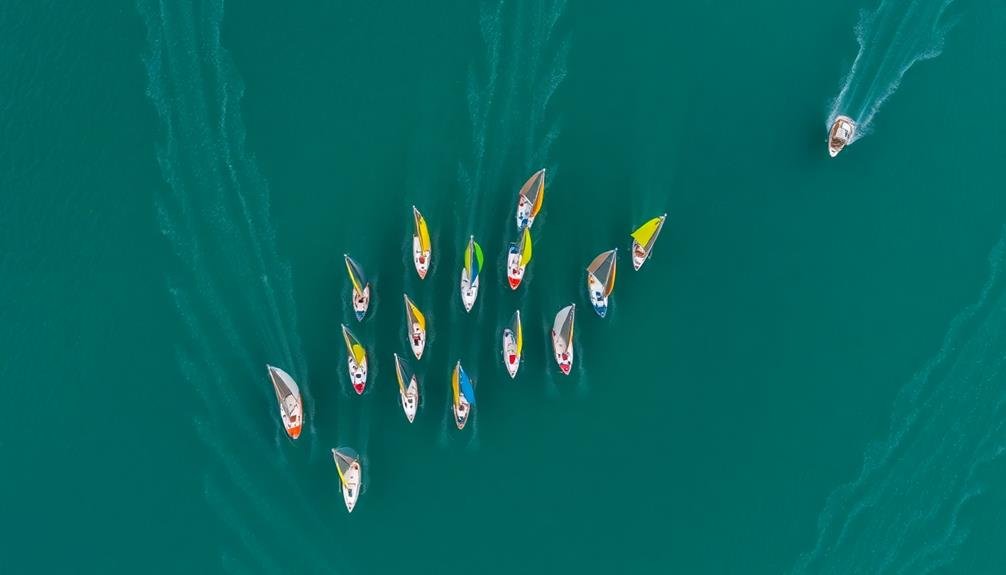
Revealing the hidden strategies of competitive sailing, tactical maneuvers become apparent as the race unfolds.
You'll notice boats employing the "tacking duel" technique, where they zigzag upwind to gain an advantage. This chess-like move forces competitors to react, potentially pushing them off course.
From above, you'll spot sailors executing the "covering" strategy. Here, lead boats position themselves between their rivals and the next mark, effectively blocking their wind.
You'll also observe the "layline" approach, where crews aim to reach turning marks in a single tack or gybe, minimizing distance traveled.
As the fleet progresses, you'll witness the "pinching" maneuver. Boats sail slightly higher than their ideal angle, sacrificing speed for a better position.
In contrast, some crews opt for "footing," sailing slightly lower to gain speed at the expense of height.
You'll see the "kedging" technique in action during light winds, where sailors drop their anchor to avoid drifting backward with the current.
Regatta Infrastructure Overview
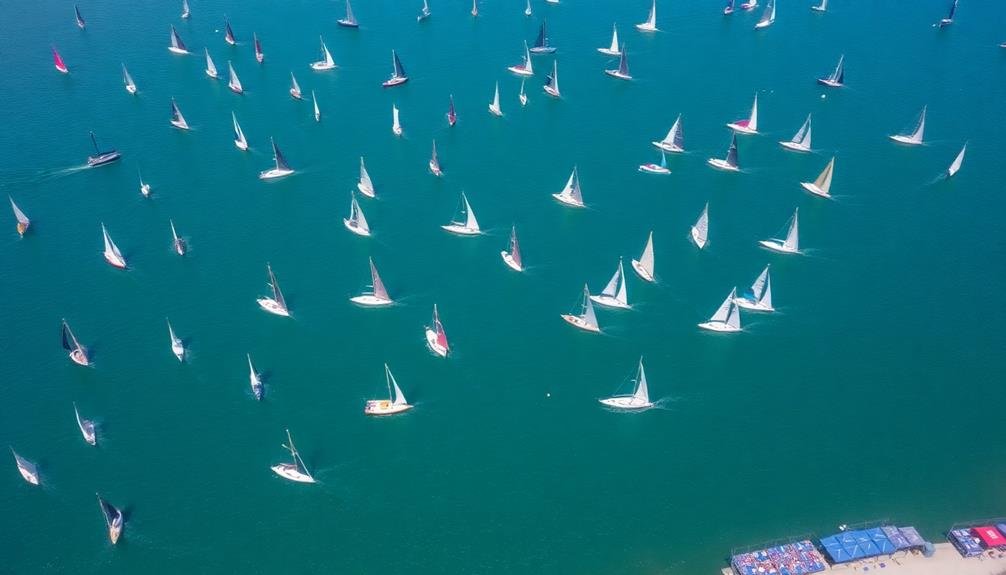
Behind the scenes of every sailing regatta lies a complex network of support systems and structures. You'll find an intricate web of infrastructure that guarantees the event runs smoothly and safely. From the water to the shore, organizers meticulously plan every aspect of the regatta.
On the water, you'll see a fleet of support vessels, including safety boats, judge boats, and mark-laying boats. These craft are essential for maintaining race integrity and participant safety. Buoys and markers define the course, while floating platforms may serve as start and finish lines.
On land, the infrastructure is equally impressive:
- Race headquarters: A hub of activity where officials coordinate the event
- Viewing areas: Strategically placed spots for spectators to watch the action
- Boat storage and launch facilities: Secure areas for competitors to store and prepare their vessels
- Media centers: High-tech spaces for journalists and broadcasters to cover the event
You'll also notice temporary structures like tents, stages, and hospitality areas. These create a vibrant atmosphere for participants and spectators alike.
Advanced communication systems link all these elements, guaranteeing seamless coordination throughout the regatta.
Unique Vantage Points

While sailing regattas are thrilling from any angle, certain vantage points offer truly spectacular views of the action. You'll find that elevated positions provide the most thorough overview of the event. Coastal cliffs or nearby hills can give you a bird's-eye view of the entire race course, allowing you to track multiple boats simultaneously and appreciate the strategic maneuvers of the sailors.
If you're lucky enough to access a tall building or observation deck near the regatta, you'll have an unparalleled perspective. From here, you can witness the intricate patterns formed by the boats as they tack and jibe across the water. Helicopter tours offer an even more dynamic experience, letting you follow the race from above and capture stunning aerial photographs.
For a unique vantage point on the water, consider chartering a spectator boat. You'll be close to the action while still maintaining a safe distance from the competing vessels.
Alternatively, if the regatta takes place near a pier or jetty, you can position yourself at the end for an excellent view of the start or finish line, where the excitement reaches its peak.
Frequently Asked Questions
How Do Drones Impact the Safety and Fairness of Sailing Regattas?
You'll find drones impact regattas in multiple ways. They can enhance safety by monitoring conditions and boats. However, they may also raise fairness concerns if used to gain tactical advantages or invade competitors' privacy during races.
What Are the Environmental Concerns Associated With Large-Scale Sailing Events?
You'll find that large sailing events can harm marine ecosystems. They often generate pollution, disturb wildlife, and damage seabeds. Fuel spills, waste disposal, and noise pollution are also concerns. You should consider these impacts when organizing or attending regattas.
How Do Sailing Regattas Contribute to Local Economies and Tourism?
You'll find sailing regattas boost local economies by attracting visitors who spend money on hotels, restaurants, and shops. They create jobs, increase tourism revenue, and showcase the area's natural beauty, encouraging future visits and investments in the region.
What Technological Advancements Have Improved the Spectator Experience in Recent Years?
You'll find drone footage and live streaming have revolutionized spectator experiences. You can now watch real-time GPS tracking of boats, access instant replays, and view 360-degree cameras on yachts. Interactive apps also provide race stats and sailor profiles.
How Do Organizers Manage the Logistics of Multi-Day, International Sailing Competitions?
You'll find organizers juggling complex tasks: coordinating with multiple countries, arranging accommodation for crews, managing race schedules, and handling weather-related changes. They're also ensuring safety measures, tracking boats, and organizing spectator areas for smooth international regattas.
In Summary
You'll gain a whole new appreciation for sailing regattas from above. The aerial view transforms the event into a mesmerizing spectacle of geometric patterns, vibrant colors, and synchronized movement. You're treated to a unique perspective that reveals tactical nuances and the sheer scale of the competition. From the excitement of the start line to the graceful choreography of vessels, you'll witness the regatta's beauty and complexity in ways impossible from the ground.

As educators and advocates for responsible drone use, we’re committed to sharing our knowledge and expertise with aspiring aerial photographers.
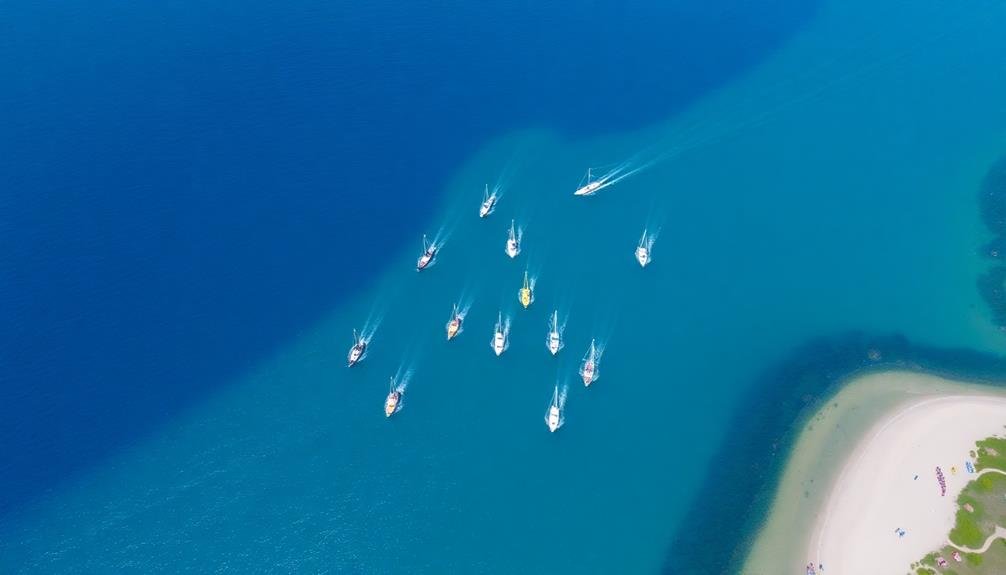



Leave a Reply